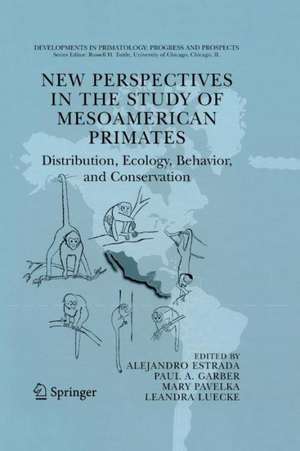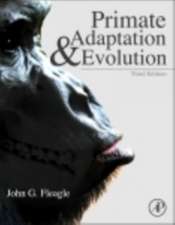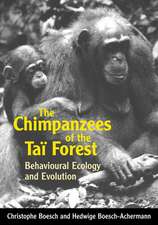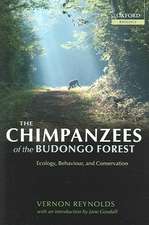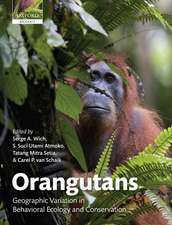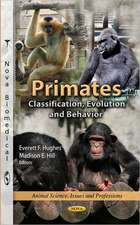New Perspectives in the Study of Mesoamerican Primates: Distribution, Ecology, Behavior, and Conservation: Developments in Primatology: Progress and Prospects
Editat de Alejandro Estrada, Paul A. Garber, Mary S. M. Pavelka, LeAndra Lueckeen Limba Engleză Paperback – 22 oct 2014
| Toate formatele și edițiile | Preț | Express |
|---|---|---|
| Paperback (1) | 1232.09 lei 6-8 săpt. | |
| Springer – 22 oct 2014 | 1232.09 lei 6-8 săpt. | |
| Hardback (1) | 1238.23 lei 6-8 săpt. | |
| Springer – 31 oct 2005 | 1238.23 lei 6-8 săpt. |
Din seria Developments in Primatology: Progress and Prospects
- 20%
 Preț: 571.32 lei
Preț: 571.32 lei - 18%
 Preț: 1216.65 lei
Preț: 1216.65 lei - 19%
 Preț: 578.67 lei
Preț: 578.67 lei - 18%
 Preț: 956.69 lei
Preț: 956.69 lei - 18%
 Preț: 948.92 lei
Preț: 948.92 lei - 18%
 Preț: 948.92 lei
Preț: 948.92 lei - 18%
 Preț: 945.79 lei
Preț: 945.79 lei - 18%
 Preț: 962.66 lei
Preț: 962.66 lei - 18%
 Preț: 1664.43 lei
Preț: 1664.43 lei - 18%
 Preț: 1224.54 lei
Preț: 1224.54 lei - 24%
 Preț: 826.26 lei
Preț: 826.26 lei - 24%
 Preț: 802.76 lei
Preț: 802.76 lei - 18%
 Preț: 1562.94 lei
Preț: 1562.94 lei - 18%
 Preț: 950.21 lei
Preț: 950.21 lei - 18%
 Preț: 943.73 lei
Preț: 943.73 lei - 18%
 Preț: 1549.67 lei
Preț: 1549.67 lei - 18%
 Preț: 1248.20 lei
Preț: 1248.20 lei - 18%
 Preț: 941.38 lei
Preț: 941.38 lei - 24%
 Preț: 800.87 lei
Preț: 800.87 lei - 18%
 Preț: 953.35 lei
Preț: 953.35 lei - 18%
 Preț: 1827.48 lei
Preț: 1827.48 lei - 18%
 Preț: 1209.52 lei
Preț: 1209.52 lei - 18%
 Preț: 957.62 lei
Preț: 957.62 lei - 18%
 Preț: 1231.47 lei
Preț: 1231.47 lei - 18%
 Preț: 1225.48 lei
Preț: 1225.48 lei - 5%
 Preț: 1433.83 lei
Preț: 1433.83 lei - 18%
 Preț: 1231.16 lei
Preț: 1231.16 lei - 18%
 Preț: 1226.90 lei
Preț: 1226.90 lei - 18%
 Preț: 955.25 lei
Preț: 955.25 lei - 18%
 Preț: 956.03 lei
Preț: 956.03 lei - 18%
 Preț: 1218.53 lei
Preț: 1218.53 lei - 18%
 Preț: 950.52 lei
Preț: 950.52 lei -
 Preț: 416.82 lei
Preț: 416.82 lei - 18%
 Preț: 1554.89 lei
Preț: 1554.89 lei
Preț: 1232.09 lei
Preț vechi: 1502.55 lei
-18% Nou
Puncte Express: 1848
Preț estimativ în valută:
235.79€ • 256.03$ • 198.06£
235.79€ • 256.03$ • 198.06£
Carte tipărită la comandă
Livrare economică 23 aprilie-07 mai
Preluare comenzi: 021 569.72.76
Specificații
ISBN-13: 9781489995131
ISBN-10: 1489995137
Pagini: 620
Ilustrații: XVI, 600 p.
Dimensiuni: 155 x 235 x 33 mm
Greutate: 0.86 kg
Ediția:2006
Editura: Springer
Colecția Springer
Seria Developments in Primatology: Progress and Prospects
Locul publicării:New York, NY, United States
ISBN-10: 1489995137
Pagini: 620
Ilustrații: XVI, 600 p.
Dimensiuni: 155 x 235 x 33 mm
Greutate: 0.86 kg
Ediția:2006
Editura: Springer
Colecția Springer
Seria Developments in Primatology: Progress and Prospects
Locul publicării:New York, NY, United States
Public țintă
ResearchCuprins
Movements of a wild night monkey (Aotus trivirgatus).- Overview of the Mesoamerican Primate Fauna, Primate Studies, and Conservation Concerns.- Taxonomy and Biogeography.- Introduction: Taxonomy and Biogeography.- Taxonomy and Distributions of Mesoamerican Primates.- The Biogeographic History of Mesoamerican Primates.- Population Responses to Disturbance.- Introduction: Population Responses to Disturbance.- Demographic Features of Alouatta pigra Populations in Extensive and Fragmented Forests.- Population Structure of Black Howlers (Alouatta pigra) in Southern Belize and Responses to Hurricane Iris.- The Effects of Forest Fragment Age, Isolation, Size, Habitat Type, and Water Availability on Monkey Density in a Tropical Dry Forest.- Forest Fragmentation and Its Effects on the Feeding Ecology of Black Howlers (Alouatta pigra) from the Calakmul Area in Mexico.- Intestinal Parasitic Infections in Alouatta Pigra in Tropical Rainforest in Lacandona, Chiapas, Mexico: Implications for Behavioral Ecology and Conservation.- Behavior and Ecology.- Introduction: Behavior and Ecology.- Average Body Weight for Mantled Howling Monkeys (Alouatta palliata): An Assessment of Average Values and Variability.- An Exploratory Analysis of Developmental Plasticity in Costa Rican Mantled Howler Monkeys (Alouatta palliata palliata).- Travel Patterns and Spatial Mapping in Nicaraguan Mantled Howler Monkeys (Alouatta palliata).- Use of Landmark Cues to Locate Feeding Sites in Wild Capuchin Monkeys (Cebus capucinus): An Experimental Field Study.- Leap, Bridge, or Ride? Ontogenetic Influences on Positional Behavior in Cebus and Alouatta.- Food Choice by Juvenile Capuchin Monkeys (Cebus capucinus) in a Tropical Dry Forest.- Why Be Alpha Male? Dominance and Reproductive Success in Wild White-Faced Capuchins (Cebus capucinus).- Post-conceptive Mating in White-Faced Capuchins, Cebus capucinus: Hormonal and Sociosexual Patterns of Cycling, Noncycling, and Pregnant Females.- Conservation and Management Policies.- Introduction: Conservation and Management Policies.- Growth of a Reintroduced Spider Monkey (Ateles geoffroyi) Population on Barro Colorado Island, Panama.- Primates in Agroecosystems: Conservation Value of Some Agricultural Practices in Mesoamerican Landscapes.- Primate Populations in the Protected Forests of Maya Archaeological Sites in Southern Mexico and Guatemala.- Mapping Primate Populations in the Yucatan Peninsula, Mexico: A First Assessment.- A Metapopulation Approach to Conserving the Howler Monkey in a Highly Fragmented Landscape in Los Tuxtlas, Mexico.- Quantifying Fragmentation of Black Howler (Alouatta pigra) Habitat after Hurricane Iris (2001), Southern Belize.- Synopsis and Perspectives.- New Perspectives in the Study of Mesoamerican Primates: Concluding Comments and Conservation Priorities.
Recenzii
From the reviews:
"There has, until now, been no synthesis of what is known about Meso-American primates. Which is one of the reasons that New Perspectives in the Study of Mesoamerican Primates is so welcome … . Part of Springer's excellent ‘Developments in Primatology’ series, the book’s 43 authors cover a wide variety of topics, with a depth and breadth that will be of great use not only to current and future researchers working on primates in the region but form the bases for productive comparisons … ." (Adrian A. Barnett, Primate Eye, October, 2006)
"New Perspectives in the Study of Mesoamerican Primates is an interesting book covering a wide range of topics with reference to a selected group of primate taxa. It will be an important reference book for primatologists in general and especially for persons working with capuchins, howlers and spider monkeys. Moreover, the book should definitely be in libraries of Mesoamerica, accessible to the Latin American primatologists who, during the next several decades, will bear the responsibility of protecting and preserving them." (E. Fernandez-Dugue, International Journal of Primatology, Vol. 28, 2007)
"There has, until now, been no synthesis of what is known about Meso-American primates. Which is one of the reasons that New Perspectives in the Study of Mesoamerican Primates is so welcome … . Part of Springer's excellent ‘Developments in Primatology’ series, the book’s 43 authors cover a wide variety of topics, with a depth and breadth that will be of great use not only to current and future researchers working on primates in the region but form the bases for productive comparisons … ." (Adrian A. Barnett, Primate Eye, October, 2006)
"New Perspectives in the Study of Mesoamerican Primates is an interesting book covering a wide range of topics with reference to a selected group of primate taxa. It will be an important reference book for primatologists in general and especially for persons working with capuchins, howlers and spider monkeys. Moreover, the book should definitely be in libraries of Mesoamerica, accessible to the Latin American primatologists who, during the next several decades, will bear the responsibility of protecting and preserving them." (E. Fernandez-Dugue, International Journal of Primatology, Vol. 28, 2007)
Caracteristici
Presents an overview of recent advances in primate field research, ecology and conservation biology in Mesoamerica Includes supplementary material: sn.pub/extras
